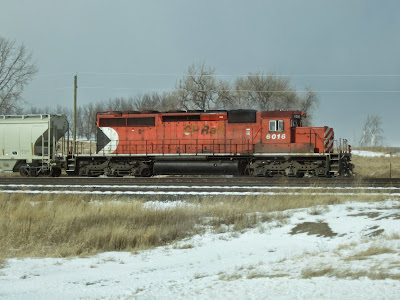The day, wasn't the best weather wise, as we drove through a snow storm from Minneapolis until almost to Fargo. After the storm cleared, the winds were roaring at what must have been at least 80 kilometres per hour. Not the best for railfanning, or driving to say the least.
Once we were west of Fargo, the BNSF northern mainline was within view of I-94, but the weather still wasn't favourable, and we wanted to make good time on the day, so that left me waiting to catch some trains (from the car) until we met the CP mainline near Carrington, North Dakota.
Once in Carrington, we did a quick driver swap, so that I could rest from driving, and take some pictures. It just so happened that where we pulled over to switch, ILSX 1328 was in view.
ISLX is the abbreviation of Independent Locomotive Services, and 1328 is an SD38 that now acts as the switcher for Central City Grain in Carrington. Prior to ISLX purchase, 1328 was PC 6935.
After snapping the above shot, we quickly got back on the road, and continued on.
It wasn't long until we came across some CP trains. The first was CP 198 parked just north of Harvey. 198 was lead by CP 9597, and had a mid train DPU in the form of CP 9823.
|
|
|
As we approached the tail end of 198, it was clear that there was an oil train sitting in the siding, waiting to move north, and was being lead by a BNSF unit!
 |
| BNSF 4672 on the head end of a northbound oil train. Harvey, ND |
The next train was CP 6016 in the siding at Drake. 6016 in the "Pac-Man" scheme, was in control of a local train of a whole 2 cars.
 |
|
|
|
|
A few hours later, as we were beginning to get closer to the border crossing at Portal, I spotted a train parked in the distance. Using the digital zoom to its maximum (resulting in a not so great picture), a Norfolk Southern unit sits with another unknown unit. I could be wrong, but I am fairly sure these units were parked on the Western Sub of the Dakota, Missouri Valley, and Western Railway.
A few minutes later, we arrived at the border crossing back into Canada at Portal.
At this point, it was starting to get dark, but we got lucky with catching a northbound just as we were crossing over the CP Weyburn Sub at Estevan. CP 9814, CSX 4837, and CP 8857 were leading a northbound mixed freight. Not a bad catch for my first train in Saskatchewan!
|
|
|
Our trip finally came to an end late on March 3, 2015. It was an interesting trip. Wish we had more time, but I am glad that I got to see what I did.





















